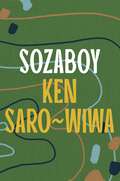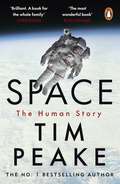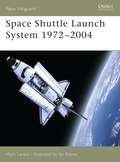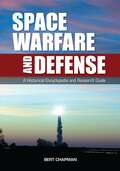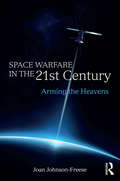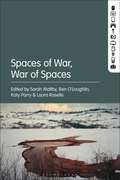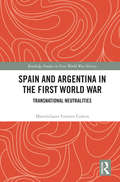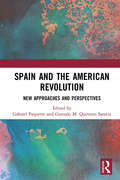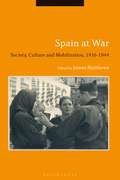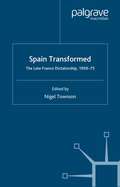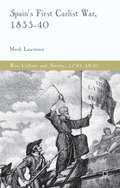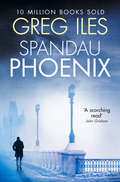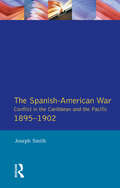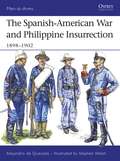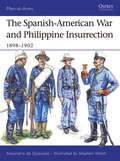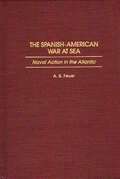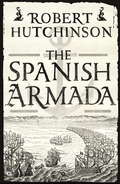- Table View
- List View
Sozaboy
by Ken Saro-WiwaSozaboy powerfully describes the fate of a young, naive soldier thrown into the frontline of a civil war, from his first proud days of recruitment to the disillusionment and horrors that follow.Mene yearns for manhood. He dreams of gaining the glory that the ex-soldier in his village brags about, with his stories of hunting 'Hitla'. So when war breaks out and soldiers appear in Mene's isolated village, he sees his chance to finally wear a uniform. Too soon, however, Mene's innocence turns to terror. While witnessing the unfathomable, Mene must learn to evade the carnage of warfare if he wants to make it home alive...Writing in Nigerian Pidgin English, Ken Saro-Wiwa creates a unique window into the dark consequences of meaningless war.'Haunting.' Guardian 'Sozaboy is not simply a great African novel, it is also a great anti-war novel, among the very best the twentieth century has produced.' William Boyd
Space: A thrilling human history by Britain's beloved astronaut Tim Peake
by Tim PeakeFrom bestselling author and British astronaut Tim Peake, an inspirational human history of space travel, from the Apollo missions to our future forays to Mars. The Right Stuff for a new generation.'This book is brilliant - once in a blue moon. A book for the whole family.' Chris Evans, Virgin Radio'The most wonderful book ... Tim Peake is a historian and encyclopaedia of space.’ Rory Stewart'An extraordinary book. For anyone - even if you’re not interested in Space. If you’re interested in human stories and the human character - this is delightful.' BBC Breakfast'A fascinating, detailed, playful book drawn from extensive research – Peake met seven Apollo astronauts, Russian cosmonauts and various other space technicians – as well as his considerable personal experience. Lifts the lid on what space is like: the dedication and sacrifice; the politics and pantomime; the practicalities and the peril; the glory and fame; the adjustment back to normal life.' iPaper'A thrilling human history of space' Daily Mirror'The bible of space travel' Chris Moyles, Radio XAs seen in the major TV series Secrets of Our Universe with Tim Peake.Only 656 people in human history have left Earth. In Space: The Human Story, astronaut Tim Peake traces the lives of these remarkable men and women who have forged the way, from Yuri Gagarin to Neil Armstrong, from Valentina Tereshkova to Peggy Whitson.Full of exclusive new stories, and astonishing detail only an astronaut would know, the book conveys what space exploration is really like: the wondrous view of Earth, the surreal weightlessness, the extraordinary danger, the surprising humdrum, the unexpected humour, the newfound perspective, the years of training, the psychological pressures, the gruelling physical toll, the thrill of launch and the trepidation of re-entry. The book also examines the surprising, shocking and often poignant stories of astronauts back on Earth, whose lives are forever changed as they readjust to terra firma.Publication of the book comes on the eve of NASA's plans to return to the moon, fifty years after an astronaut last walked on the lunar surface. In 2024 the Artemis II mission will send four astronauts to orbit the moon. In 2025 Artemis III will send the first woman and the first person of colour to step on the lunar surface. What will separate these upcoming moonwalkers from the legendary Apollo crews? Does it still take a daring-do attitude, super-human fitness, intelligence, plus the 'Right-stuff' - a fabled grace under pressure? And how will astronauts travel even further - to Mars and beyond? Space: The Human Story reveals all.
Space Shuttle Launch System 1972–2004 (New Vanguard)
by Ian Palmer Mark LardasThe Space Shuttle is one of the oldest and most famous manned launch systems – the only launch vehicle that has been used for a longer period of time is the Soviet (now Russian) R-7 booster. By the start of the third millennium, the Space Shuttle had carried crews into space over 85 times. Although not a military structure, the Shuttle had been sold as an all-purpose launch system to be used jointly for military and civilian purposes. Featuring full-colour photos throughout, this book covers the design, development and operational history of a unique vehicle.
Space Shuttle Launch System 1972–2004 (New Vanguard #99)
by Ian Palmer Mark LardasThe Space Shuttle is one of the oldest and most famous manned launch systems – the only launch vehicle that has been used for a longer period of time is the Soviet (now Russian) R-7 booster. By the start of the third millennium, the Space Shuttle had carried crews into space over 85 times. Although not a military structure, the Shuttle had been sold as an all-purpose launch system to be used jointly for military and civilian purposes. Featuring full-colour photos throughout, this book covers the design, development and operational history of a unique vehicle.
Space Warfare and Defense: A Historical Encyclopedia and Research Guide
by Bert ChapmanThis timely resource provides a history of the development of space weapons and warfare strategies and a comprehensive reference guide to the growing literature on the subject.Space Warfare and Defense: A Historical Encyclopedia and Research Guide provides comprehensive coverage of the development of space as a possible arena for warfare, exploring the military uses of space—past, present, and future—and specific details of actual space weapons systems.The encyclopedia spans the breadth of U.S. military space policy; comparable programs in the Soviet Union, China, and the European Union; and the full array of international agreements designed to regulate the military uses of space. In addition, the encyclopedia includes an extensive reference guide (nearly 40 percent of the book) directing readers to the essential literature on space weapons and defense systems produced by the United States, other governments, research institutions, and additional sources. At a time when space is becoming an increasingly important place of military competition and potential conflict, Space Warfare and Defense dispels the myths and examines the realities of what may become humanity's ultimate battlefield.
Space Warfare in the 21st Century: Arming the Heavens (Cass Military Studies)
by Joan Johnson-FreeseThis book examines the recent shift in US space policy and the forces that continually draw the US back into a space-technology security dilemma. The dual-use nature of the vast majority of space technology, meaning of value to both civilian and military communities and being unable to differentiate offensive from defensive intent of military hardware, makes space an area particularly ripe for a security dilemma. In contrast to previous administrations, the Obama Administration has pursued a less militaristic space policy, instead employing a strategic restraint approach that stressed multilateral diplomacy to space challenges. The latter required international solutions and the United States, subsequently, even voiced support for an International Code of Conduct for Space. That policy held until the Chinese anti-satellite (ASAT) test in 2013, which demonstrated expanded Chinese capabilities. This volume explores the issues arising from evolving space capabilities across the world and the security challenges this poses. It subsequently discusses the complexity of the space environment and argues that all tools of national power must be used, with some degree of balance, toward addressing space challenges and achieving space goals. This book will be of much interest to students of space policy, defence studies, foreign policy, security studies and IR.
Space Warfare in the 21st Century: Arming the Heavens (Cass Military Studies)
by Joan Johnson-FreeseThis book examines the recent shift in US space policy and the forces that continually draw the US back into a space-technology security dilemma. The dual-use nature of the vast majority of space technology, meaning of value to both civilian and military communities and being unable to differentiate offensive from defensive intent of military hardware, makes space an area particularly ripe for a security dilemma. In contrast to previous administrations, the Obama Administration has pursued a less militaristic space policy, instead employing a strategic restraint approach that stressed multilateral diplomacy to space challenges. The latter required international solutions and the United States, subsequently, even voiced support for an International Code of Conduct for Space. That policy held until the Chinese anti-satellite (ASAT) test in 2013, which demonstrated expanded Chinese capabilities. This volume explores the issues arising from evolving space capabilities across the world and the security challenges this poses. It subsequently discusses the complexity of the space environment and argues that all tools of national power must be used, with some degree of balance, toward addressing space challenges and achieving space goals. This book will be of much interest to students of space policy, defence studies, foreign policy, security studies and IR.
Spaces of War, War of Spaces
by Laura Roselle Sarah Maltby Katy Parry Ben O’LoughlinSpaces of War, War of Spaces provides a rich, international and multi-disciplinary engagement with the convergence of war and media through the conceptual lens of 'space'. 'Space' offers a profound, challenging and original framework through which notions of communication, embodiment, enactment, memory and power are interrogated not only in terms of how media spaces (traditional, digital, cultural, aesthetic, embodied, mnemonic) transform the conduct, outcomes and consequences of war for all involved, but how 'war' actors (political, military, survivors, victims) recreate space in a manner that is transformative across political, social, cultural and personal spheres. Foregrounding the work of artists, activists and practitioners alongside more traditional scholarly approaches Spaces of War, War of Spaces engages with the 'messiness' of war and media through the convergence of practice and theory, where showing and embodying is made explicit.
Spaces of War, War of Spaces
Spaces of War, War of Spaces provides a rich, international and multi-disciplinary engagement with the convergence of war and media through the conceptual lens of 'space'. 'Space' offers a profound, challenging and original framework through which notions of communication, embodiment, enactment, memory and power are interrogated not only in terms of how media spaces (traditional, digital, cultural, aesthetic, embodied, mnemonic) transform the conduct, outcomes and consequences of war for all involved, but how 'war' actors (political, military, survivors, victims) recreate space in a manner that is transformative across political, social, cultural and personal spheres. Foregrounding the work of artists, activists and practitioners alongside more traditional scholarly approaches Spaces of War, War of Spaces engages with the 'messiness' of war and media through the convergence of practice and theory, where showing and embodying is made explicit.
Spain 1936: Year Zero (Liverpool Studies in Spanish History)
by Raanan Rein Joan ThomasMarking the 80th anniversary of the outbreak of the Spanish Civil War, this volume takes a close look at the initial political moves, military actions and consequences of the fratricidal conflict and their impact on both Spaniards and contemporary European powers. The contributors re-examine the crystallization of the political alliances formed in the Republican and the Nationalist zones; the support mobilized by the two warring camps; and the different attitudes and policies adopted by neighbouring and far away countries. Spain 1936: Year Zero goes beyond and against commonly held assumptions as to the supposed unity of the Nationalist camp vis-a-vis the fragmentation of the Republican one; and likewise brings to the fore the complexities of initial support of the military rebellion by Nazi Germany and Soviet support of the beleaguered Republic. Situating the Iberian conflict in the larger international context, senior and junior scholars from various countries challenge the multitude of hitherto accepted ideas about the beginnings of the Spanish Civil War. A primary aim of the editors is to enable discussion on the Spanish Civil War from lesser known or realized perspectives by investigating the civil wars impact on countries such as Argentina, Japan, and Jewish Palestine; and from lesser heard voices at the time of women, intellectuals, and athletes. Original contributions are devoted to the Popular Olympiad organized in Barcelona in July 1936, Japanese perceptions of the Spanish conflict in light of the 1931 invasion to Manchuria, and international volunteers in the International Brigades.
Spain and Argentina in the First World War: Transnational Neutralities (Routledge Studies in First World War History)
by Maximiliano Fuentes CoderaThis is the first book that analyzes the transnational impact of the Great War simultaneously on two countries, Spain and Argentina, that remained neutral throughout the conflict. Both countries were very relevant in the conception of propaganda and policies of belligerent countries such as France, Germany and Great Britain and showed that the conflict had a global influence and affected deeply local political and cultural processes, even in areas geographically distant from the trenches. Within this framework, this book is focused on three aspects that are analyzed dynamically throughout the whole war from a transnational perspective: neutrality as a space of dispute between pro-Allies and pro-German sectors and its relation with local politics, the debate about what positions should be assumed in order to guarantee a world without war, and the polemics on the ideas of nations and supra-nations (Hispanism, Latinism, Pan-Americanism). The conclusions of the book highlight that the radicalization that exploded in 1917 in both countries was fundamental in shaping the political radicalization of the last months of the conflict and the postwar period. As happened in Europe, the Great War did not finish in 1918 and its traces continued in the 1920s and 1930s.
Spain and Argentina in the First World War: Transnational Neutralities (Routledge Studies in First World War History)
by Maximiliano Fuentes CoderaThis is the first book that analyzes the transnational impact of the Great War simultaneously on two countries, Spain and Argentina, that remained neutral throughout the conflict. Both countries were very relevant in the conception of propaganda and policies of belligerent countries such as France, Germany and Great Britain and showed that the conflict had a global influence and affected deeply local political and cultural processes, even in areas geographically distant from the trenches. Within this framework, this book is focused on three aspects that are analyzed dynamically throughout the whole war from a transnational perspective: neutrality as a space of dispute between pro-Allies and pro-German sectors and its relation with local politics, the debate about what positions should be assumed in order to guarantee a world without war, and the polemics on the ideas of nations and supra-nations (Hispanism, Latinism, Pan-Americanism). The conclusions of the book highlight that the radicalization that exploded in 1917 in both countries was fundamental in shaping the political radicalization of the last months of the conflict and the postwar period. As happened in Europe, the Great War did not finish in 1918 and its traces continued in the 1920s and 1930s.
Spain and the American Revolution: New Approaches and Perspectives
by Gabriel Paquette Gonzalo M. Quintero SaraviaThough the participation of France in the American Revolution is well established in the historiography, the role of Spain, France’s ally, is relatively understudied and underappreciated. Spain's involvement in the conflict formed part of a global struggle between empires and directly influenced the outcome of the clash between Britain and its North American colonists. Following the establishment of American independence, the Spanish empire became one of the nascent republic's most significant neighbors and, often illicitly, trading partners. Bringing together essays from a range of well-regarded historians, this volume contributes significantly to the international history of the Age of Atlantic Revolutions.
Spain and the American Revolution: New Approaches and Perspectives
by Gabriel Paquette Gonzalo M. Quintero SaraviaThough the participation of France in the American Revolution is well established in the historiography, the role of Spain, France’s ally, is relatively understudied and underappreciated. Spain's involvement in the conflict formed part of a global struggle between empires and directly influenced the outcome of the clash between Britain and its North American colonists. Following the establishment of American independence, the Spanish empire became one of the nascent republic's most significant neighbors and, often illicitly, trading partners. Bringing together essays from a range of well-regarded historians, this volume contributes significantly to the international history of the Age of Atlantic Revolutions.
Spain at War: Society, Culture and Mobilization, 1936-44
by James MatthewsSpain's principal and most devastating war during the 20th century was, unusually for most of Europe, an internal conflict. During the Spanish Civil War of 1936 to 1939 two competing armies – the insurgent and counterrevolutionary Nationalist Army and the Republican Popular Army – engaged in a conflict to impose their version of Spanish identity and the right to shape the country's future. In its aftermath, Francoist Spain remained on a war footing for the duration of the Second World War. In spite of the unabated flood of books on the Spanish Civil War and its consequences, historians of Spain in the 20th century have focused relatively little on the interaction of society and culture, and their roles in wartime mobilization. Spain at War addresses this omission through an examination of individual experiences of conflict and the mobilization of society. This edited volume acknowledges the agency of low-ranking individuals and the impact of their choices upon the historical processes that shaped the conflict and its aftermath. In doing so, this new military history provides a more complex and nuanced understanding of Spain's most intense period of wartime cultural mobilization between the years 1936 to 1944 and challenges traditional political accounts of the period.
Spain at War: Society, Culture and Mobilization, 1936-44
by James MatthewsSpain's principal and most devastating war during the 20th century was, unusually for most of Europe, an internal conflict. During the Spanish Civil War of 1936 to 1939 two competing armies – the insurgent and counterrevolutionary Nationalist Army and the Republican Popular Army – engaged in a conflict to impose their version of Spanish identity and the right to shape the country's future. In its aftermath, Francoist Spain remained on a war footing for the duration of the Second World War. In spite of the unabated flood of books on the Spanish Civil War and its consequences, historians of Spain in the 20th century have focused relatively little on the interaction of society and culture, and their roles in wartime mobilization. Spain at War addresses this omission through an examination of individual experiences of conflict and the mobilization of society. This edited volume acknowledges the agency of low-ranking individuals and the impact of their choices upon the historical processes that shaped the conflict and its aftermath. In doing so, this new military history provides a more complex and nuanced understanding of Spain's most intense period of wartime cultural mobilization between the years 1936 to 1944 and challenges traditional political accounts of the period.
Spain Transformed: The Franco Dictatorship, 1959-1975
by N. TownsonSpain Transformed addresses the sweeping social and cultural changes that characterized the late Franco regime. This wide-ranging collection reassesses the dictatorship's latter years by drawing on a wealth of new material and ideas, using an interdisciplinary approach.
Spain's First Carlist War, 1833-40 (War, Culture and Society, 1750-1850)
by M. LawrenceSpain's First Carlist War was an unlikely agent of modernity. It pitted town against country, subalterns against elites, and Europe's Liberal powers against Absolute Monarchies. This book traces the individual, collective and international experience of this conflict, giving equal attention to battle fronts and home fronts.
Spandau Phoenix (A\world War Ii Thriller Ser.)
by Greg IlesThe New York Times No.1 bestseller delivers ‘a scorching read’ (John Grisham). One of the great unsolved mysteries of World War II is – to some people – a secret worth killing for…
The Spanish-American War 1895-1902: Conflict in the Caribbean and the Pacific
by Joseph SmithFought in both Caribbean and Pacific and turning on America's superior naval strength, this short but decisive war had momentous consequences internationally. It ended Spain's imperial power, and the US emerged for the first time as an active force in world affairs, acquiring -- amidst much domestic controversy -- an empire of her own in the Philippines, Guam, Puerto Rico, and Cuba (whose struggle against Spain had sparked the war). Heavy with implications for twentieth-century America, the war is explored in its widest context in this engrossing and impressive study.
The Spanish-American War 1895-1902: Conflict in the Caribbean and the Pacific
by Joseph SmithFought in both Caribbean and Pacific and turning on America's superior naval strength, this short but decisive war had momentous consequences internationally. It ended Spain's imperial power, and the US emerged for the first time as an active force in world affairs, acquiring -- amidst much domestic controversy -- an empire of her own in the Philippines, Guam, Puerto Rico, and Cuba (whose struggle against Spain had sparked the war). Heavy with implications for twentieth-century America, the war is explored in its widest context in this engrossing and impressive study.
The Spanish-American War and Philippine Insurrection: 1898–1902 (Men-at-Arms)
by Stephen Walsh Alejandro De QuesadaThis book details the uniforms and weapons of the American, Spanish, Cuban and Filipino forces involved in the United States Army's first overseas war. In 1898 the USA took the decision to intervene in the Cuban war of independence against Spain, and to expel the last vestige of European colonial rule from the Americas. This also led to the US acquiring rule over the Philippine Islands; and there, US troops were sent into the jungle to fight a "colonial†? war of their own, against Filipino insurgents unwilling to exchange one master for another. The text is illustrated with rare early photographs and color plates.
The Spanish-American War and Philippine Insurrection: 1898–1902 (Men-at-Arms #437)
by Stephen Walsh Alejandro De QuesadaThis book details the uniforms and weapons of the American, Spanish, Cuban and Filipino forces involved in the United States Army's first overseas war. In 1898 the USA took the decision to intervene in the Cuban war of independence against Spain, and to expel the last vestige of European colonial rule from the Americas. This also led to the US acquiring rule over the Philippine Islands; and there, US troops were sent into the jungle to fight a "colonial†? war of their own, against Filipino insurgents unwilling to exchange one master for another. The text is illustrated with rare early photographs and color plates.
The Spanish-American War at Sea: Naval Action in the Atlantic (Non-ser.)
by A. B. FeuerBy piecing together diaries, letters, scrapbooks, and rare privately printed memoirs, the author has created a story which tells how America's ragtag navy—composed mainly of converted yachts, steamers and tugboats—was able to fight and win against the more powerful Spanish gunboats. The naval battles fought in places like Santiago, Cardenas, Cienfuegos, Manzanillo, Port Nipe, Guantanamo, San Juan, Guanica, and Ponce come alive in this book. The stories of the brave little ships that fought these battles—with names like the Gloucester and the Yosemite—at times against overwhelming odds, demonstrates the excellent training of the men who manned their guns under leadership of daring officers. This book fills in many of the missing pieces in the history of the Spanish-American War.
The Spanish Armada: A History
by Robert HutchinsonA dramatic blow-by-blow account of the defeat of the Spanish Armada by the English fleet - a tale of derring-do and disaster on the high seas by one of our best narrative historians.After the accession of Elizabeth I in 1558, Protestant England was beset by the hostile Catholic powers of Europe - not least Spain. In October 1585 King Philip II of Spain declared his intention to destroy Protestant England and began preparing invasion plans, leading to an intense intelligence war between the two countries, culminating in the dramatic sea battles of 1588.Robert Hutchinson's tautly written book is the first to examine this battle for intelligence, and uses everything from contemporary eye-witness accounts to papers held by the national archives in Spain and the UK to recount the dramatic battle that raged up the English Channel. Contrary to popular theory, the Armada was not defeated by superior English forces - in fact, Elizabeth I's parsimony meant that her ships had no munitions left by the time the Armada had fought its way up to the south coast of England. In reality it was a combination of inclement weather and bad luck that landed the killer blow on the Spanish forces, and of the 125 Spanish ships that set sail against England, only 60 limped home - the rest sunk or wrecked with barely a shot fired.
